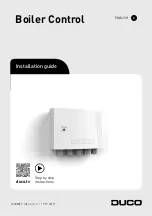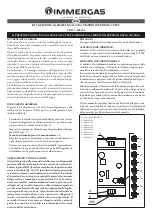
12
CIAO GREEN C.S.I.
The “combustion analysis” function is automatically deactivated if the board
triggers an alarm. In the event of a fault during the combustion analysis
cycle, carry out the reset procedure.
table 1
MAXIMUM NUMBER OF
FAN ROTATIONS
METHANE
GAS (G20)
LIQUID GAS
(G31)
25 C.S.I.
heating - DHW
49 - 61
49 - 61
rpm
29 C.S.I.
heating - DHW
53 - 62
52 - 60
rpm
table 2
MINIMUM NUMBER OF FAN
ROTATIONS
METHANE
GAS (G20)
LIQUID GAS
(G31)
14
14
rpm
table 3
Max. CO
2
METHANE
GAS (G20)
LIQUID GAS
(G31)
9,0
10,5
%
table 4
Min. CO
2
METHANE
GAS (G20)
LIQUID GAS
(G31)
9,5
10,5
%
table 5
SLOW IGNITION
METHANE
GAS (G20)
LIQUID GAS
(G31)
40
40
rpm
b
If the CO
2
values do not correspond to the values in the Multigas
table, make further adjustments.
4.7 Gas conversion (fig. 42-43)
Gas conversion from one family of gases to another can also be easily
performed when the boiler is installed.
This operation must be carried out by professionally qualified personnel.
The boiler is designed to operate with methane gas (G20) according to the
product label.
It is possible to convert the boiler to propane gas, using the special kit.
For disassembly, refer to the instructions below:
- switch off the power supply to the boiler and close the gas tap
- remove in sequence: housing and air distribution box cover
- remove the fixing screw from the instrument panel
- unhook and turn the instrument panel forwards
- remove the gas valve (
A
)
- remove the nozzle (
B
) inside the gas valve and replace it with the nozzle
from the kit
- refit the gas valve
- remove the silencer from the mixer
- open the two half-shells by prising apart the corresponding hooks (
C
)
- replace the air diaphragm (
D
) in the silencer
- refit the air distribution box cover
- re-power the boiler and turn on the gas tap
Adjust the boiler as described in the chapter “Adjustments” with reference
to the information on LPG.
b
Conv
ersion must be carried out by qualified personnel.
b
Onc
e the conversion is complete, affix the new identification
label supplied in the kit.
4.8 Checking the combustion parameters
- Position the function selector on
to switch off the boiler
- Turn the DHW temperature selector on
.
Wait until the ignition of the burner (about 6 seconds). The display shows
“ACO”, the boiler operates at full power heating.
- Remove the screw
C
and the cover
E
on the air box (fig. 41).
- Insert the probes of the analyzer in the positions provided on the air box.
b
T
he flue gas analysis probe must be fully inserted as far as
possible.
- Check that the CO
2
values match those given in the table, if the value
shown is different, change it as indicated in the chapter entitled “Gas
valve calibration”.
Max. CO
2
METHANE
GAS (G20)
LIQUID GAS
(G31)
9,0
10,5
%
Min. CO
2
METHANE
GAS (G20)
LIQUID GAS
(G31)
9,5
10,5
%
-
Perform the combustion check.
- Check the flue combustion.
The “combustion analysis” remains active for a time limit of 15 min; in the
event it is reached in a flow temperature of 90 °C the burner shutdown.
It will turn back when this temperature falls below 78 °C.
If you wish to stop the process turn the hot water temperature in the area
between the “+” and “-”.
Then:
- remove the analyser probe and close the sockets for combustion analysis
with the special screw
-
close the instrument panel and refit the housing.
5 - MAINTENANCE
During boiler maintenance the use of protective clothing is
recommended, in order to avoid personal injury.
The appliance must be systematically controlled at regular intervals to
make sure it works correctly and efficiently and conforms to legislative
provisions in force.
The frequency of controls depends on the conditions of installation and
usage, it being anyhow necessary to have a complete check carried out
by authorized personnel from the Technical Assistance Service every year.
- Check and compare the boiler’s performance with the relative
specifications. Any cause of visible deterioration must be immediately
identified and eliminated.
- Closely inspect the boiler for signs of damages or deterioration,
particularly with the drainage and aspiration system and electrical
apparatus.
- Check and adjust – where necessary – all the burner’s parameters.
- Check and adjust – where necessary – the system’s pressure.
- Analyze combustion. Compare results with the product’s specification.
Any loss in performance must be identified and corrected by finding and
eliminating the cause.
- Make sure the main heat exchanger is clean and free of any residuals or
obstruction; if necessary, clean it.
- Check and clean – where necessary – the condensation tray to make
sure it works properly.
- Check that the atmospheric tube is not obstructed.
b
After routine and extraordinary maintenance operations have
been carried out, fill the siphon, following the instructions in the
section “Switching on the appliance”.
IMPORTANT
: always switch off the power to the appliance and close the
gas by the gas cock on the boiler before carrying out any maintenance and
cleaning jobs on the boiler.
Do not clean the appliance or any latter part with flammable substances
(e.g. petrol, alcohol, etc.).
Do not clean panelling, enamelled and plastic parts with paint solvents.
Panels must be cleaned with ordinary soap and water only.
BURNER CLEANING
The flame side of the burner is made with an innovative material of the
latest generation.
- Be especially careful during the dismantling, handling and installation
of the burner and the components next to it (e.g.. electrodes, insulation
panels, etc.)
- Avoid direct contact with any cleaning device (e.g. brushes, vacuum
cleaners, blowers, etc.).
In general, the burner does not require maintenance, but particular cases
may occur where cleaning is necessary (e.g.. distribution network of gas
containing solid particles and in the absence of a filter on the line, suction
air containing excessively adhesive particulates, etc.).
For this reason, perform a visual control of the burner in order to ensure the
proper functioning of the product:
-
Remove the front cover of the air box
- Unscrew the fastening nut of the gas train to the valve, remove the gas
train spring clip to the mixer and turn the gas train outwards
-
Remove the silencer from the mixer
- Disconnect the connectors of the wiring from the fan and the connecting
cables of the electrodes
-
Unscrew the fixing screws and remove the exchanger-fan cover
assembly from its seat
-
Unscrew the fixing screws and remove the burner from its seat checking
it condition.
b
If necessary, clean the burner with compressed air, blowing from
the metal side of the burner.
b
I
t is possible that with ageing, the fibres constituting the flame
side of the burner can tone the colour.
-
Reassemble everything in reverse order.
b
If necessary, proceed with the replacement of the sealing
gas
kets.
The manufacturer declines all responsibility for any damage caused from
the failure to observe that stated above.













































